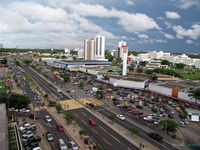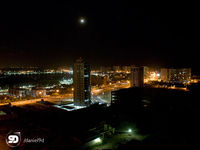São Luís, Maranhão
| São Luís | |||
|---|---|---|---|
| — Municipality — | |||
| The Municipality of São Luís do Maranhão |
|||
 |
|||
|
|||
 |
|||
 São Luís
|
|||
| Coordinates: | |||
| Country | |||
| Region | Northeast | ||
| State | |||
| Founded | September 8, 1612 | ||
| Government | |||
| - Mayor | João Castelo (PSDB) | ||
| Area | |||
| - Municipality | 827.141 km2 (319.360 sq mi) | ||
| Elevation | 4 m (12 ft) | ||
| Population (2008 IBGE) | |||
| - Municipality | 986,826 | ||
| - Density | 1,183.4/km2 (3,064.9/sq mi) | ||
| - Metro | 1,227,659 | ||
| Time zone | UTC-3 (UTC-3) | ||
| Postal Code | 65000-000 | ||
| Area code(s) | +55 98 | ||
| HDI (2000) | 0.778 – medium | ||
| Website | São Luís, Maranhão | ||
São Luís (lit. Saint Louis) is the capital of the Brazilian state of Maranhão. The city is located on São Luís island in the Baía de São Marcos (St Marcus Bay), an extension of the Atlantic Ocean which forms the estuary of Pindaré, Mearim, Itapecuru and other rivers. Its coordinates are 2.50° south, 44.30° west. The city proper has a population of some 986,826 people (2008 IBGE estimate). The metropolitan area totals 1,227,659 (ranked as the 16th largest in Brazil).
São Luís is the only Brazilian state capital founded by France (see France Équinoxiale) and it is one of the three Brazilian state capitals located on islands (the others are Vitória and Florianópolis).
The city has sea ports Ponta da Madeira and Porto do Itaqui, through which a substantial part of Brazil's iron ore, originating from the (pre)-Amazon region, is exported. The city's main industries are metallurgical with Alumar, and Vale do Rio Doce. São Luís is home of the Federal University of Maranhão.
São Luís was the home town of famous Brazilian Samba singer Alcione, Brazilian writers Aluísio Azevedo, Ferreira Gullar and Josué Montello, Belgian-naturalised soccer player Luís Oliveira, the musician João do Vale and Zeca Baleiro, a Música Popular Brasileira (MPB) singer.
Contents |
History
Originally the town was a large village of the Tupinambá tribe. The first Europeans to see it were the French, in 1612, who intended to make it a French colony. They built a fort named Saint Louis ("São Luís"), after Saint Louis IX of France as a compliment to King Louis XIII. It was conquered for Portugal by Jerônimo de Albuquerque in 1615, leaving little time for the French to build a city. This has led to some controversy as to the actual date of the founding of the city by the French or the Portuguese. In 1641 the city was invaded by the Dutch. They stayed until 1645 and did not manage to influence the city's architecture or to leave any sign of their invasion, mainly because they were kept too busy with the challenges to their occupation. In 1677, the city was made the seat of the Diocese of São Luís do Maranhão.
Only when those invasions ceased permanently did the colonial government decide to create the state of Grão-Pará e Maranhão, independent from the rest of the country. By that time, the economy was based on agriculture, particularly the exportation of sugar cane, cacao and tobacco. Conflicts amongst the local elites would lead to the Beckman's Revolt.
Soon after the outbreak of the American Civil War, the region started to provide cotton to England. The wealth originated by this activity was used to modernize the city; to instigate religious men to come and teach in their schools; and water supplement. The city came to be the third most populous city in the country, but by the end of the 19th century agriculture faced its decay and, from this time forth, the city has been searching for other ways of sustenance.
Nowadays, São Luís has the largest and best preserved heritage of colonial Portuguese architecture of all Latin America. The island is known as the "Island of Love" and "Brazilian Athens", due to its many poets and writers, such as Aluísio Azevedo, Graça Aranha, Gonçalves Dias (the most famous), Ferreira Gullar, among others.
Economy

The GDP for the city was R$ 9,340,944,000 (2005).[1]
The per capita income for the city was R$ 9,543 (2005).[2]
Education

Portuguese is the official national language, and thus the primary language taught in schools. But English and Spanish are part of the official high school curriculum.
Educational institutions
- Universidade Federal do Maranhão (UFMA);
- Universidade Estadual do Maranhão (UEMA);
- Centro de Ensino Universitário do Maranhão (UNICEUMA);
- Instituto Federal de Educação, Ciência e Tecnologia do Maranhão (IFMA);
- Faculdade São Luís;
- Unidade de Ensino Superior Dom Bosco (UNDB);
- Faculdade Atenas Maranhense (FAMA);
- and many others.
Culture
| Historic Centre of São Luís* | |
|---|---|
| UNESCO World Heritage Site | |
|
|
|
| State Party | |
| Type | Cultural |
| Criteria | iii, iv, v |
| Reference | 821 |
| Region** | Latin America and the Caribbean |
| Inscription history | |
| Inscription | 1997 (21st Session) |
| * Name as inscribed on World Heritage List. ** Region as classified by UNESCO. |
|
São Luís is known for its tiles which most buildings in the historical centre are covered in. Because of it the city is also known as "The Tiles City".
It also has some cultural peculiarities namely:
Tambor de Crioula
Afro-Brazilian dance in which gaily clad women court a bateria of tambors (a row of drums). Whirling and gyrating in time to the music they negotiate for prime position in the centre of the bateria.
Tambor de Mina
Not to be confused with the above, this is the local variant of the Afro-Brazilian religion Candomble.
Bumba Meu Boi
the Bumba Meu Boi is a popular farce which takes its form as a grand musical pantomime. Practice is a public affair and begins directly after Easter reaching its climax in June when literally hundreds of groups perform on a nightly basis for popular acclaim. Set personalities and characters play out a comedic tragedy with a metaphor for social harmony at its heart. Settlers, the infamous "Coroneis", Indians, spirit workers, African slaves and forest spirits are enacted though costumes, choreography and music - all performed amongst the all-night revelry. The crowd joins in with singing, dancing and dependent on the groups sotaque (or style) the playing of matracas (two wooden blocks, held in each hand and struck together repeatedly). Like the festival of Sao João and its requisite Forró dance in the North-Eastern states further south Bumba Meu Boi is a harvest festival but with the bull as its centre-piece.
Capoeira
The São Luís form of capoeira is said to be akin to the kind of capoeira now recognized as 'traditional bahian capoeira' that predated the Bahian Angola/regional polemic which split the capoeira world in the 1950s.
Historical Center
In 1997 the city's historical center was made a UNESCO World Heritage Site. Starting in 1989 there has been an extensive program to restore and renovate the colonial era buildings of the city's historical center.
Transport
Air
The city is served by the Marechal Cunha Machado International Airport.
Public transport
There are 150 bus lines operating in the city, forming a fleet of more than 1.100 buses.
Media and communication
Television
- TV Brasil São Luís (TV Brasil) (former TVE MA or TV Educativa) - Channel 2
- TV Difusora (SBT) - 4
- TV Cidade (Rede Record) - 6
- TV São Luís (RedeTV!) - 8
- TV Mirante - (Rede Globo) - 10
- TV Maranhense (former TV Praia Grande) (Rede Bandeirantes) - 12
- São Luís TV (MTV Brasil) - 18
- Rede Internacional de Televisão - 20
- Record News São Luís (Record News) - 23
- TV Educadora (Rede Vida - 26
- TV Upaon-Açú - 28
- Boas Novas São Luís - 31
- TV Alternativa (Rede Gazeta) - 34 (signal of Paço do Lumiar)
- TV Athenas (Rede 21) - 39
- TV Aparecida - 48
- TV Nazaré - 53
Radios
- AM:
- 560 - Rádio Educadora (RCR SAT)
- 600 - Rádio Mirante AM,
- 680 - Rádio Difusora (Rede Aleluia)
- 1180 - Rádio Capital
- 1290 - Rádio Timbira
- 1340 - Rádio São Luís AM (Jovem Pan Sat)
- FM:
- 94.3 - Rádio Difusora FM
- 96.1 - Rádio Mirante FM
- 99.1 - Rádio Cidade FM
- 100.9 - Rádio Esperança FM (Rede Transmundial)
- 102.5 - Rádio São Luís FM (Rede Jovem Pan 2FM)
- 106.9 - Universidade FM.
- 99.8 - Gurupi Alemanha
Newspapers
- O Imparcial
- O Estado do Maranhão
- Jornal Pequeno
- O Debate
- O Correio de Notícias
- Aqui Maranhão
Phones
- Telephone
- Oi
- Embratel.
- Cellphone
- Vivo S.A.
- Tim
- Claro
- Oi
References
- ↑ (in Portuguese) (PDF) GDP. São Luís, Brazil: IBGE. 2005. ISBN 85-240-3919-1. http://www.ibge.gov.br/home/estatistica/economia/pibmunicipios/2005/tab01.pdf. Retrieved 2007-07-18.
- ↑ (in Portuguese) (PDF) per capita income. São Luís, Brazil: IBGE. 2005. ISBN 85-240-3919-1. http://www.ibge.gov.br/home/estatistica/economia/pibmunicipios/2005/tab01.pdf. Retrieved 2007-07-18.
External links
- Official city site
- Flickr photos from Sao Luis
- Aerial pictures from the City of Sao Luis made with powered paraglider
|
||||||||||||||||||||||||||||||||||||||
|
||||||||||||||||||||||||||||||||
|
||||||||||||||||||||
|
|||||||||||
|
|||||||||||||||||||||||